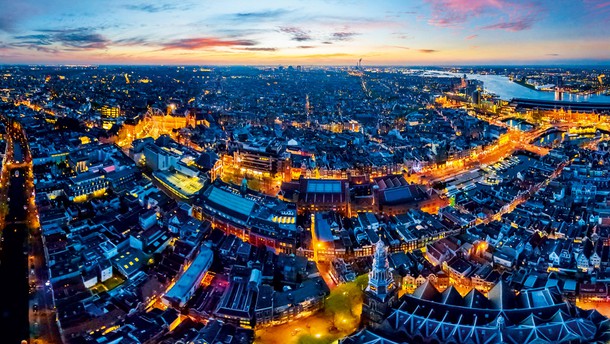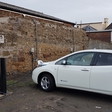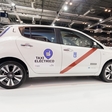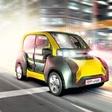
While the city only harbored 74 electric vehicles (EVs) in 2011, thousands of EVs now cruise around town, and Amsterdam aims to be emission free in 2025. How did the city manage to move ahead so quickly, and how will the sky-high goal for 2025 be reached? Plugin Magazine visited the city, spoke with numerous stakeholders and tried to find the answers.
Infrastructure
The solid foundation under Amsterdam's ambitions in electric transport is an extensive public network of EV charging points, with high visibility throughout the city, and providing guaranteed charging facilities to electric drivers. It started in 2009, with a few public charging points, but the city now hits the gas with 756 chargers in 2014, 1300 in 2015 and it plans to expand to 4000 by 2018. Art van der Giessen, the project manager for electric transport in Amsterdam, is enthusiastic: "We are determined to take electric transport to the next level. Within ten years, everyone should be able to drive electric in this city. To reach this, we will facilitate and stimulate electric driving with necessary infrastructure and privileges for early adaptors. Currently we have about 2050 public charging points and 50,000 charging sessions each month. The number of unique users of the network is now 8500 and grows continuously. And what's even more interesting in Amsterdam is the source of the electricity. We have a wind farm in the Amsterdam harbor that produces the electricity for the charging points. So it's as sustainable as possible." Besides huge numbers, the city concentrates on the interoperability of charging stations, ensuring that any car can be charged at any station with a standard plug.

The proof of the pudding is in the eating, so we checked out the reality on the ground in Amsterdam's museum quarter, around the corner of the Rijksmuseum, Van Gogh Museum and the Museum of Modern Art. Isabel, a senior banker who was just charging her plug-in Volkswagen, is content: "Though I'm driving a plug-in with a limited range (50 km), it's easy to move around solely on electric. Charging stations are never more than a block away, and I simply recharge during meetings. Amsterdam is really a unique place to drive like this."
While cruising through the neighborhood, it's easy to see what she means. The signs for parking lots with charging stations can be found on almost any street, and often with more than one per street. An online realtime map shows all charging stations in Amsterdam in blue (occupied) or green (available). An extra advantage for electric drivers is that they get priority while waiting for parking permits in the busy areas of the city. While the hardware is clearly put in place to allow for carefree electric driving, financial incentives sweeten the transition to use EVs.

A subsidy scheme by the city allows for a 5000 euro subsidy for small vans, taxis and cars used for businesses. Furthermore, buyers of huge vans, trucks and buses can receive 20% of the sale price as a subsidy. An expensive program, but stimulating a rapid growth in EVs. Finally, Amsterdam has set a maximum price suppliers of energy are allowed to charge electric drivers, in order to make electric driving attractive and affordable.
Amsterdam as Testing Ground for Electric Driving
While the municipality tries to facilitate the use of EVs as much as possible, Amsterdam has not gone unnoticed by international companies working with EVs. In 2011, Car2Go chose Amsterdam to launch the full version of their car-sharing concept. The city-wide parking permit for electric car-sharing cars, and the installation of the extensive public charging network, made Amsterdam the perfect place to introduce their concept, with a fleet of 300 electric Smarts. We contacted Car2Go for this article and were informed that they completely renewed their fleet in 2014, and even expanded the number of EVs.

Isabel is a plug-in hybrid VW Passate driver, but driving mostly on electricity, as she charges her car regularly during the day.
Amsterdam was also picked by BMW, when they launched their first fully-electric vehicle, the BMW i3. We asked BMW about the current number of full electric cars driving in Amsterdam and they checked all the fully-electric BMW i3s that are registered at postal codes from Amsterdam. They found that there are currently 104 cars of this type in the city. Given the large number of different EV and plug-in models that have been introduced in the last couple of years, this number for one model seems quite substantial, and illustrates the popularity of EVs there.
Taxis
At the taxi ranks in Amsterdam, the fumes of diesel slowly evaporate. At Amsterdam's central train station, four fast chargers were installed this year, and more will follow soon. With these chargers, taxis can charge their cars within 20 to 30 minutes. A recent analyses of the use of the chargers by the municipality showed that the chargers were active almost non-stop. Besides the fast chargers at central station, nine other fast chargers were installed that are used by taxis, but may also be used by other vehicles. Furthermore, the use of electric taxis is boosted by the priority they get at a number of crucial taxi ranks. Electric taxis have priority over other taxis in the queue. At Amsterdam Schiphol Airport, two taxi companies got a license in 2014 to use the official taxi ranks at the airport. They are driving with 167 Tesla Model S verhicles, probably making Schiphol as the airport with the most electric taxis anywhere in the world.

Emission-Free Movers and Beer Trucks
Among the many regular EVs in Amsterdam, a rather special kind of vehicle can be found. Jan Laan, director of Aad de Wit Mondial Movers, a 86 year-old moving company based in Catricum and Amsterdam, explained his pioneering work: "In 2011, I and my business partner witnessed the launch of the first electric Nissan Leaf. Shortly after, we took the most irrational decision of our careers: we decided to buy an electric removal truck. This was madness, to be honest. There are no such things as electric removal trucks. You need to strip a diesel and convert it, which is expensive. Nevertheless, we decided to go ahead with our plan, because we felt we had to do it. Eventually, with the support of a number of partners, including the Amsterdam city council, we managed to pull it off." Since the first unique electric truck, things have gone quickly with more trucks, electric vans, electric scooters and PHEVs. Over 70% of the fleet of the company now has a plug. And in fact, the moving business seems ideal for electric driving. As Jan Laan explains, in practice most trucks are standing still the major part of the time, and don't need to travel a lot of kilometers in a short period. Adding to this company are two major Dutch beer brands that have come up with creative slogans, drawing attention to their expanding fleet of electric trucks. According to the municipality, there are currently more than 30 electric trucks operated by local companies on Amsterdam's roads.

Turning Driving Into Science
Amsterdam's public charging infrastructure is without compare. The Amsterdam University of Applied Sciences (AUAS) collects data on the more than 2000 charging points and 50,000 charging sessions each month. In recent years, dozens of researchers and students have worked on the analysis of this data, in a series of unique research projects resulting in valuable input for decision-making. This interaction between science and policy aims to ensure a future-proof charging infrastructure. One of the problems the researchers have signalled are so-called "excess users." They charge their car for over 24 hours in one uninterrupted session. As a result, 20% of total connectivity is accounted for by a tiny group of only 3% of all users. With the use of science, the grid of charging stations can be continuously improved, both technically and by showing where human behavior needs to be adjusted. Combined with the financial incentives, they maximize the chances of Amsterdam either reaching its goal for 2025, or at least setting new records in electric mobility, year after year, and showing the way forward for other cities in the Netherlands and around the world.
Text: Edgar Tijhuis



